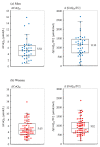CYP7A1, NPC1L1, ABCB1, and CD36 Polymorphisms Are Associated with Increased Serum Coenzyme Q10 after Long-Term Supplementation in Women
- PMID: 33799730
- PMCID: PMC7998724
- DOI: 10.3390/antiox10030431
CYP7A1, NPC1L1, ABCB1, and CD36 Polymorphisms Are Associated with Increased Serum Coenzyme Q10 after Long-Term Supplementation in Women
Abstract
Coenzyme Q10 (CoQ10), an essential component for energy production that exhibits antioxidant activity, is considered a health-supporting and antiaging supplement. However, intervention-controlled studies have provided variable results on CoQ10 supplementation benefits, which may be attributed to individual CoQ10 bioavailability differences. This study aimed to investigate the relationship between genetic polymorphisms and CoQ10 serum levels after long-term supplementation. CoQ10 levels at baseline and after one year of supplementation (150 mg) were determined, and eight single nucleotide polymorphisms (SNPs) in cholesterol metabolism and CoQ10 absorption, efflux, and cellular uptake related genes were assessed. Rs2032582 (ABCB1) and rs1761667 (CD36) were significantly associated with a higher increase in CoQ10 levels in women. In addition, in women, rs3808607 (CYP7A1) and rs2072183 (NPC1L1) were significantly associated with a higher increase in CoQ10 per total cholesterol levels. Subgroup analyses showed that these four SNPs were useful for classifying high- or low-responder to CoQ10 bioavailability after long-term supplementation among women, but not in men. On the other hand, in men, no SNP was found to be significantly associated with increased serum CoQ10. These results collectively provide novel evidence on the relationship between genetics and CoQ10 bioavailability after long-term supplementation, which may help understand and assess CoQ10 supplementation effects, at least in women.
Keywords: bioavailability; cholesterol; coenzyme Q10; single nucleotide polymorphisms.
Conflict of interest statement
The authors declare that they have no competing interests.
Figures




Similar articles
-
CYP7A1, NPC1L1, ABCB1, and CD36 Polymorphisms Associated with Coenzyme Q10 Availability Affect the Subjective Quality of Life Score (SF-36) after Long-Term CoQ10 Supplementation in Women.Nutrients. 2022 Jun 22;14(13):2579. doi: 10.3390/nu14132579. Nutrients. 2022. PMID: 35807759 Free PMC article.
-
Association between genetic variants in the Coenzyme Q10 metabolism and Coenzyme Q10 status in humans.BMC Res Notes. 2011 Jul 21;4:245. doi: 10.1186/1756-0500-4-245. BMC Res Notes. 2011. PMID: 21774831 Free PMC article.
-
Bioavailability of Reduced Coenzyme Q10 (Ubiquinol-10) in Burn Patients.Metabolites. 2022 Jul 1;12(7):613. doi: 10.3390/metabo12070613. Metabolites. 2022. PMID: 35888737 Free PMC article.
-
Clinical Evidence for Q10 Coenzyme Supplementation in Heart Failure: From Energetics to Functional Improvement.J Clin Med. 2020 Apr 27;9(5):1266. doi: 10.3390/jcm9051266. J Clin Med. 2020. PMID: 32349341 Free PMC article. Review.
-
Effectiveness of Coenzyme Q10 Supplementation for Reducing Fatigue: A Systematic Review and Meta-Analysis of Randomized Controlled Trials.Front Pharmacol. 2022 Aug 24;13:883251. doi: 10.3389/fphar.2022.883251. eCollection 2022. Front Pharmacol. 2022. PMID: 36091835 Free PMC article.
Cited by
-
Autosomal Recessive Cerebellar Ataxias: Translating Genes to Therapies.Ann Neurol. 2025 Sep;98(3):448-470. doi: 10.1002/ana.27271. Epub 2025 Jun 4. Ann Neurol. 2025. PMID: 40464291 Free PMC article. Review.
-
CYP7A1, NPC1L1, ABCB1, and CD36 Polymorphisms Associated with Coenzyme Q10 Availability Affect the Subjective Quality of Life Score (SF-36) after Long-Term CoQ10 Supplementation in Women.Nutrients. 2022 Jun 22;14(13):2579. doi: 10.3390/nu14132579. Nutrients. 2022. PMID: 35807759 Free PMC article.
-
Coenzyme Q biochemistry and biosynthesis.Trends Biochem Sci. 2023 May;48(5):463-476. doi: 10.1016/j.tibs.2022.12.006. Epub 2023 Jan 24. Trends Biochem Sci. 2023. PMID: 36702698 Free PMC article. Review.
-
Mitochondrial Genetic Background May Impact Statins Side Effects and Atherosclerosis Development in Familial Hypercholesterolemia.Int J Mol Sci. 2022 Dec 28;24(1):471. doi: 10.3390/ijms24010471. Int J Mol Sci. 2022. PMID: 36613915 Free PMC article.
References
-
- Tian G., Sawashita J., Kubo H., Nishio S.-Y., Hashimoto S., Suzuki N., Yoshimura H., Tsuruoka M., Wang Y., Liu Y., et al. Ubiquinol-10 Supplementation Activates Mitochondria Functions to Decelerate Senescence in Senescence-Accelerated Mice. Antioxid. Redox Signal. 2014;20:2606–2620. doi: 10.1089/ars.2013.5406. - DOI - PMC - PubMed
Grants and funding
LinkOut - more resources
Full Text Sources
Other Literature Sources

